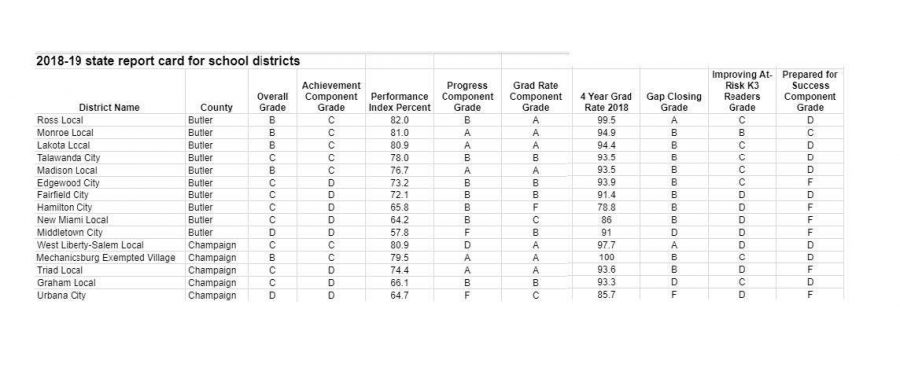The Ohio Department of Education has released “report cards” on every school district in the state for the 2018/2019 school year.
Talawanda City School District’s overall grade went down to a “C” from the “B” it received the previous year.
“The report card doesn’t truly measure how much learning and improvement is truly occurring to educate a whole child,” said Edward Theroux, Talawanda’s superintendent while explaining the grade.
Each school in the district received an overall grade as well as a grade in six specific categories. The categories are: achievement, progress, gap closing, graduation rate, improving at-risk K-3 readers and how prepared the students are for success. The achievement component represents student performance on state tests and whether or not students have met certain benchmarks and how well students did overall. The progress component represents the growth of all students based on their previous performances. The gap closing component represents how well each specific school is doing performance-wise in English, math and graduation rates.
The graduation component represents the percentage of students that graduate from high school within four-to-five-year period. The at-risk K-3 readers category represents how successful the district is at helping students who struggle with reading to get back on track for third grade and in the future. Finally, prepared for success component represents how prepared students are for their future.
Among the elementary schools, Kramer Elementary received the best overall grade, with a B. Marshall was second, with a C, and Bogan Elementary received a D. Kramer Elementary received B’s in all areas. Marshall received a D in achievement, a C in improving at-risk K-3 readers and B’s in progress and gap closing. Bogan had a C in at risk K-3 reader but received a D in the achievement component, a D in progress, and an F in the gap closing component.
The Talawanda Middle School received an overall grade of B. They received B’s in progress and gap closing and a C in achievement.
To top it all off, Talawanda High School received an overall grade of a C as well as C’s in the achievement and progress components. The high school received B’s in gap closing and graduation and then a D in prepared for success.
“We definitely have work to do,” Theroux said. Staff across the different schools in the district are starting to meet to go over the Report Card data, he said.
But Theroux noted that simplifying school assessments into A, B, C, D and F “report card” grades does not show the whole picture of how well a school is educating its students.
The state report card test is not the only data that the Talawanda School District uses. Theroux cited informal measures which deal with teacher observations; more formal measures dealing with star testing, administered to certain students by third-party testers approved by the Ohio Department of Education; as well as curriculum-based measures and curriculum assessments.

The district has a strategic plan that went into place this year. The four areas in the strategic plan are teaching and learning, social and emotional, communication and engagement and financial responsibility. Theroux also said each building has a plan that fits the students in that building. Lastly, he said, there are individual student plans which help students academically as well as in other areas.
“We don’t just want to focus on just test scores, we are looking at how a student is doing overall.” Theroux said.
The superintendent is not the only local official looking at the report card data. Kathleen Knight-Abowitz, a Miami University education professor running for a seat on the school board this fall, said a school’s performance isn’t just based on lesson: “One thing we know, the report card grade measures the wealth of the district”.
A study of last year’s report cards across the state that was conducted by Cleveland.com, reported that wealthier districts get better grades on their state report cards.









